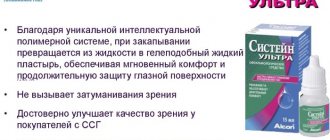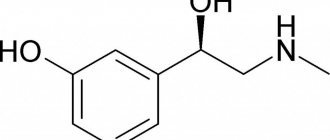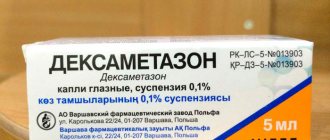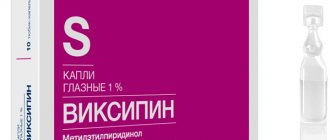Compound
One bottle of Irifrin 10% contains phenylephrine hydrochloride - 100 mg, and one bottle of Irifrin 2.5% - 25 mg.
Excipients: benzalkonium chloride, disodium edetate, sodium hydroxide, sodium hydrogen phosphate dihydrate, anhydrous sodium dihydrogen phosphate, sodium metabisulfite , citric acid, sodium citrate dihydrate , purified water.
One bottle of Irifrin BK (without preservative) 2.5% contains phenylephrine hydrochloride - 25 mg.
Pharmacodynamics and pharmacokinetics
Pharmacodynamics
Phenylephrine is an adrenergic agonist with alpha-adrenergic activity. When taken in normal doses, it does not produce a stimulating effect on the central nervous system.
When used locally in ophthalmology, it stimulates the outflow of intraocular fluid, constricts the vessels of the conjunctiva and causes pupil dilation ( mydriasis ).
Phenylephrine has a strong stimulating effect on alpha-adrenergic receptors in postsynapses, has little effect on beta-adrenergic receptors in the cardiac region, and has almost no positive inotropic and chronotropic effects. The drug has a vasoconstrictor (vasoconstrictor) effect, similar to the effect of norepinephrine , but with phenylephrine it is weaker and longer lasting.
Vasoconstriction occurs 30-90 s after use, duration of action is 2-5 hours. Once administered (instilled), phenylephrine promotes contraction of the pupillary dilator, causing mydriasis . Pupil dilation is achieved within 20-60 minutes after instillation; continues after instillation of a 2.5% solution for 2 hours, 10% solution - 3-5 hours.
Pharmacokinetics
Phenylephrine freely penetrates into the tissues of the organ of vision. The maximum concentration in the blood occurs 10–20 minutes after local application. Pre-instillation of anesthetics increases absorption into the systemic circulation and prolongs mydriasis . The drug is excreted in the urine in its original form (less than 20%) and in the form of inert metabolites.
Indications for use
- The need for pupil dilation during ophthalmological diagnostic procedures (control of the posterior segment of the eye).
- Iridocyclitis (prevention of the appearance of posterior synechiae and weakening of exudation in the iris).
- Conducting a provocative study in individuals with a narrow anterior chamber angle and possible angle-closure glaucoma .
- In surgical ophthalmology during preoperative preparation for the purpose of pupil dilation.
- Differential diagnosis of deep and superficial eye injection .
- Therapy of glaucomocyclic crises .
- Performing laser interventions on the fundus of the eye and in vitreoretinal surgery .
- Therapy for red eye syndrome (to relieve hyperemia and sensitivity of the eye membranes).
- Orally and locally: to reduce swelling of the mucous membranes of the nasopharynx and conjunctiva in case of allergic and colds (as part of a combination treatment; only for Irifrin BK).
- Parenteral: to increase blood pressure during collapse and hypotension caused by a decrease in vascular tone (only for Irifrin BC).
Contraindications
- Allergy to the components of the drug.
- Angle-closure or narrow-angle glaucoma.
- Diabetes.
- Severe disorders of the cardiovascular system ( arterial hypertension , heart disease, aneurysm , tachycardia ).
- Thyrotoxicosis, hyperthyroidism.
- Use together with and within 14 days after stopping therapy with MAO inhibitors.
- Dilation of the pupil during surgery in patients with a defect in the integrity of the eye or in cases of impaired outflow of tear fluid.
- Concomitant use with tricyclic antidepressants, antihypertensive drugs (including beta blockers ).
- Congenital deficiency of glucose-6-phosphate hydrogenase .
- Porphyria.
- Low birth weight newborns.
Overdose symptoms
An overdose of a drug is manifested by an increase in its systemic effects. The reasons may be frequent instillation of a solution with a high concentration, non-compliance with doctor's recommendations and the simultaneous use of other phenylephrine-based drugs.
Read more Instructions for using eye drops Hiloparin commode
Signs of overdose include:
- headache;
- nausea and vomiting;
- pronounced vasoconstriction;
- strong pupil dilation;
- disruption of the heart;
- arterial hypertension (BP more than 139/89 mmHg);
- dryness of the mucous membranes of the eyes.
Help includes stopping the use of drops or revising the dosage, as well as the use of alpha-blockers.
Side effects
- From the eyes: conjunctivitis , swelling of the tissues of the periorbital region; possible burning sensation, irritation, blurred vision, lacrimation, discomfort, increased intraocular pressure.
- After taking Irifrin, reactive miosis . When using the drug again at this time, mydriasis is usually less pronounced. This effect is typical for older people.
- From the cardiovascular system: palpitations, tachycardia , reflex bradycardia , arrhythmia , arterial hypertension , occlusion of the coronary arteries of the heart, pulmonary embolism .
- Due to the strong contraction of the pupillary dilator caused by the action of phenylephrine, small grains of pigment from the iris . This suspension must be differentiated from anterior uveitis or the presence of blood cells in the anterior chamber cavity.
- Skin: dermatitis .
- Very rarely, when using Irifrin (10% eye drops), severe disorders occur, including vascular collapse, myocardial infarction and intracerebral hemorrhage .
Analogs
Irifrin substitutes are divided into synonyms (they have the same active substance and effect) and indirect analogues (another active ingredient, but a similar therapeutic effect). Analogs of the drug include the following medications in the form of drops and solutions:
- Neosynephrine-POS - have the same active substance;
- Visofrine - a solution containing phenylephrine;
- Mezaton - according to reviews, causes severe irritation;
- Allergophthal is a vasoconstrictor drug to eliminate redness;
- Vizin is an analogue of Irifrin, the medication relieves eye fatigue.
Irifrin eye drops, instructions for use
The instructions for Irifrin prescribe the use of drops topically.
For ophthalmoscopy, a single use of a 2.5% solution is used. For mydriasis , instillation of one drop of Irifrin 2.5% into the conjunctival sac is sufficient. Expansion of the maxillary force is achieved after 20–30 minutes and lasts for 1–3 hours. If necessary, it is possible to prolong mydriasis , for which another instillation .
In children over 12 years of age and adults with weak pupil dilation to provoke diagnostic mydriasis , the use of a 10% solution without dose adjustment is justified.
When conducting diagnostics, a single use of a 2.5% solution can be used for:
- provocative test in individuals with a narrow anterior chamber angle and possible angle-closure glaucoma ;
- differential diagnosis of the type of eye injection (superficial or deep);
- iridocyclite solution 2.5 or 10% is used to prevent the development and rupture of posterior synechiae; to reduce exudation in the anterior ocular chamber (one drop of Irifrin is instilled into the conjunctival sac 2-3 times a day);
- relief of glaucomocyclic crises . Phenylephrine produces a hypotensive effect in this pathology. A 10% solution is used 2–3 times a day;
- preparing patients for surgical interventions in 40–60 minutes to achieve pupil dilation, a single injection of a 10% solution is performed; After the integrity of the eye membranes is damaged, re-use of the drug is prohibited.
The 10% solution should not be used to soak tampons during surgery.
Irifrin BC is also used:
- for hypermetropia with a tendency to accommodation spasms, accompanied by high eye strain, the drug is instilled in the evening along with a 1% solution of cyclopentolate . With standard visual load, Irifrin BC is used before bedtime 3 times a week;
- in the treatment of true and false myopia - 1 drop before bedtime every 3 days for one month.
Forms of release from pharmacies and shelf life
Despite the fact that the medicine is used topically (not ingested), the drug is released to customers only with a prescription from a doctor. Drops should not be frozen or heated to high temperatures. For storage it must be below 25ºC. Irifrin is placed in a dark place (access to sunlight is limited), inaccessible to small children.
Read more Cetirizine drops for children and adults
After opening the package, the solution is good for a month. It is recommended to use it fresh due to possible loss of properties and reduced effectiveness. The shelf life of the drug is 24 months. After its expiration, Irifrin cannot be used.
Interaction
Pupil dilation increases when phenylephrine and atropine .
The use of a 2.5 or 10% solution of the drug with MAO inhibitors and for three weeks after their discontinuation should be done with caution, since in this case an uncontrolled increase in blood pressure is possible.
The use of Irifrin 10% in combination with beta-blockers can provoke acute arterial hypertension .
Use together with sympathomimetics may enhance the cardiovascular effects of phenylephrine.
Patient reviews
Olga, 40 years old, Samara: a doctor recently discovered iridocyclitis in my seven-year-old daughter. They prescribed 2.5 percent drops. She tolerated the medicine well. Within a few days I felt improvement. Vision was restored.
Ksenia, 33 years old, Voronezh: due to constant hard work at the computer, fatigue, headaches and blurred vision appeared. I contacted an ophthalmologist. The doctor said that I had a spasm of accommodation. Prescribed by Irifrin. After the course of treatment, my vision and general condition improved. An excellent tool.
Pavel, 18 years old, Moscow: after a week of using Irifrin, redness and fatigue disappeared. An effective and inexpensive medicine.
special instructions
Since the duration of pupil dilation can reach 1-3 hours, patients may experience a feeling of photophobia, therefore, until vision function is restored, you need to protect your eyes from strong sunlight. Reading and watching TV programs are prohibited.
It is possible to develop reactive miosis , which is more often observed in older people after using phenylephrine, and repeated use of the drug leads to a weakening of pupil dilation.
benzalkonium chloride as a preservative , it may cause discoloration of soft contact lenses. Before using Irifrin, the patient must remove the lenses and wait 15 minutes after instillation before using them again.
"Irifrin" in childhood
For children under 12 years of age, the drug is prescribed for visual impairment if a diagnosis of farsightedness or myopia is made. When a child comes to school, lessons and electives are added to his usual workload. The eyes are under stress and often in the first grades children complain of fatigue and blurred vision.
To avoid this, you need to teach your child to take short breaks when doing homework and watching TV. And at school you can do an exercise to train your eyes, turning your gaze to distant and close objects. This will benefit the baby.
Against the background of increased loads, Irifrin is used as a monthly course, drops at night in both eyes. You can prescribe two drops every other day. After a course of treatment, lacrimation and pain go away, and fatigue decreases.
Usually, the use of the drug prevents vision loss. To avoid switching to contact lenses or glasses, you need to teach children to take care of their eyes and listen to their feelings. As soon as fatigue appears, you need to take a break, do eye exercises or do a neutral activity. These techniques will help you avoid heavy loads.
Irifrin price, where to buy
The price of Irifrin 2.5% eye drops in Russia ranges from 333 to 409 rubles, Irifrin BC will cost 484-510 rubles.
In Ukraine, eye drops Irifrin 2.5% will cost 58-83 hryvnia, and the price of Irifrin BC will average 78 hryvnia.
- Online pharmacies in RussiaRussia
- Online pharmacies in UkraineUkraine
- Online pharmacies in KazakhstanKazakhstan
ZdravCity
- Irifrin eye drops 2.5% 5ml Sentiss Pharma Pvt.
Ltd. / Sentiss Pharma Pvt. Ltd. RUR 522 order - Irifrin BK eye drops 2.5% 0.4 ml 15 pcs. Sentiss Pharma Pvt. Ltd. / Sentiss Pharma Pvt. Ltd.
RUR 564 order
Pharmacy Dialogue
- Irifrin (eye drops 2.5% 5ml)Sentiss
RUR 694 order
- Irifrin BK (tb.-drops .2.5% 0.4ml No. 15)Promed Exports
RUR 718 order
- Irifrin BK 2.5% eye drops 0.4ml No. 15Sentiss
RUR 759 order
show more
Pharmacy24
- Irifrin 2.5% 5 ml No. 1 drops Sentiss Pharma PVT.LTD, India
143 UAH order
PaniPharmacy
- Irifrin liquid Irifrin eye drop bottle 2.5% 5ml India, Sentiss Pharma
177 UAH order
show more








